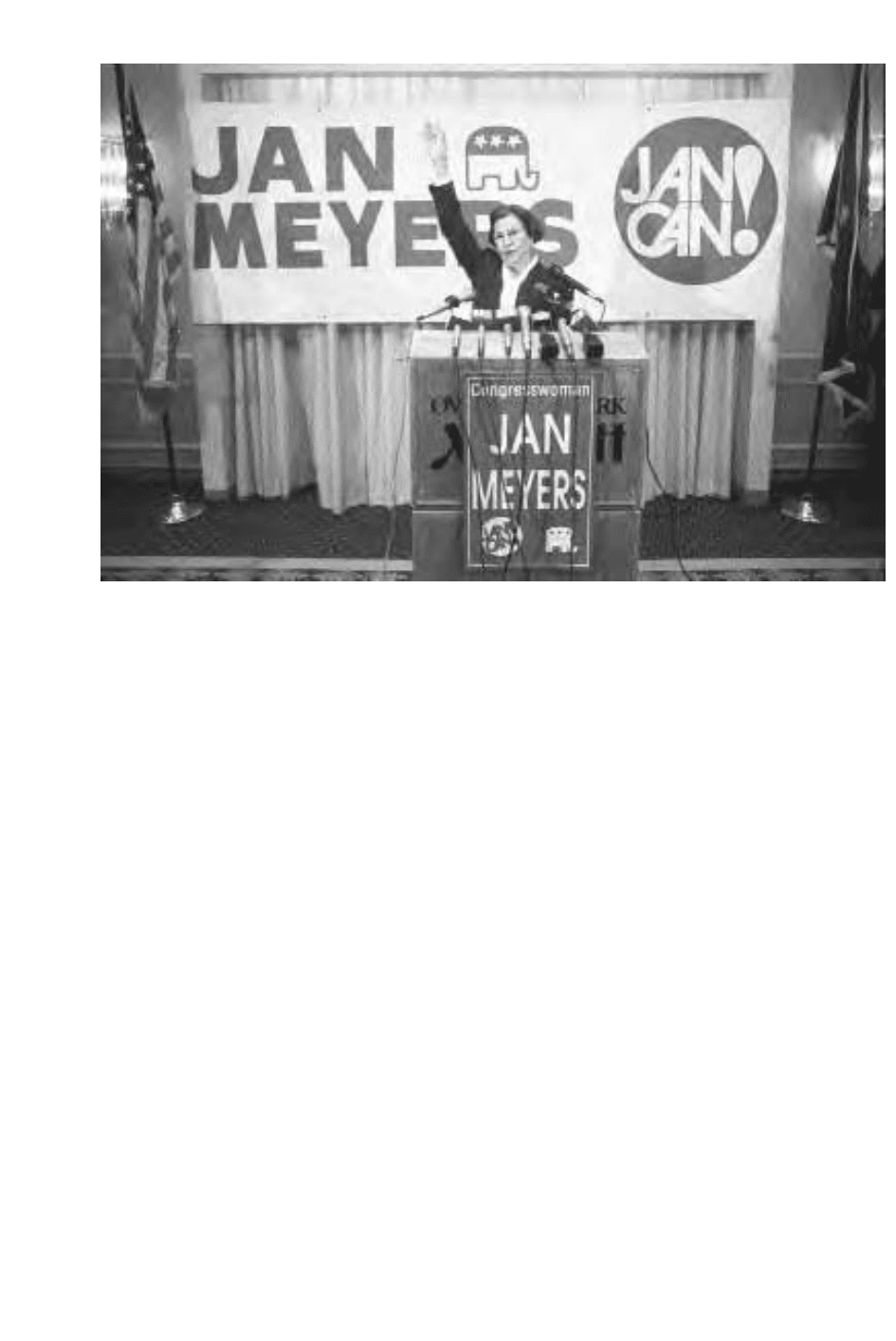Schenken Suzanne O’Dea. From Suffrage to the Senate: An Encyclopedia of American Women in Politics (2 Volumes)
Подождите немного. Документ загружается.


forcibly raping her. In addition, after refusing him several times, she had
sexual intercourse with him, events that she did not describe as rape. Vin-
son did not report the harassment because she feared her supervisor and
would have had to make the report to him.
Before Meritor, only sexual harassment that included an economic
threat (quid pro quo), such as loss of employment or employment benefits,
had been recognized, but after Meritor, a hostile work environment became
the second classification under which action could be taken. Because hostile
work environment harassment is the more common type of harassment,
the Court’s decision provides working women with another avenue for liti-
gation. The decision also stated that compliance with sexual demands does
not necessarily mean that sexual harassment did not occur, but it did state
that the woman’s dress and speech could be admitted as evidence.
See also Civil Rights Act of 1964, Title VII; Employment Discrimination; Equal
Employment Opportunity Commission; Sexual Harassment
References Fallon, “Sexual Harassment” (1995); Hoff, Law, Gender, and Injustice
(1991); Meritor Savings Bank v. Vinson, 477 U.S. 57 (1986).
Meyers, Jan (b. 1928)
Republican Jan Meyers of Kansas served in the U.S. House of Representa-
tives from 3 January 1985 to 3 January 1997. President of the Shawnee
Mission League of Women Voters from 1961 to 1965, Meyers entered elec-
tive politics when she ran for the Overland Park City Council, beginning
Meyers, Jan 435
Representative Jan
Meyers (R-KS), chair of
the House Committee
on Small Business,
announced that she
would not seek a
seventh term in
Congress, 1995
(Associated Press AP)

her tenure in 1967 and serving as president from 1970 to 1972. She served
in the Kansas Senate from 1972 to 1984. As a member of Congress, Mey-
ers passed a bill to study improvements in firefighter safety and obtained
funding for a federal building and courthouse in Kansas City, Kansas. An
unsuccessful candidate in the 1978 Kansas Republican House primary
(she lost to Nancy Kassebaum), she won an open seat in the House in
1984. Meyers chaired the House Committee on Small Business in the
104th Congress (1995–1997). Her priorities included family planning,
health care, welfare reform, budget reform, drug abuse prevention, and
energy conservation. Meyers retired in 1997.
Born in Lincoln, Nebraska, Jan Meyers earned her associate of fine
arts degree from William Woods College in 1948 and her bachelor of arts
from the University of Nebraska in 1951.
See also Congress, Women in; State Legislatures, Women in
References Congressional Quarterly, Politics in America 1994 (1993).
Meyner, Helen Day Stevenson (1929–1997)
Democrat Helen Meyner of New Jersey served in the U.S. House of Rep-
resentatives from 3 January 1975 to 3 January 1979. When the Demo-
cratic candidate for Congress was disqualified in 1972, women leaders in
the Democratic Party recruited Meyner as a last-minute replacement. She
accepted the challenge but lost in a close race. She ran again in 1974 and
was successful. In Congress, Meyner was committed to peace issues and
proposed establishing a national academy of peace and conflict resolu-
tion. She was instrumental in keeping open the Army’s Picatinny Arsenal
in her district by having the Armament Research and Development Com-
mand transferred there. She also sought to reduce defense spending. She
worked for the Equal Rights Amendment and for appropriations for the
National Women’s Conference. Meyner was defeated in her attempt for a
third term.
Born in New York, New York, Helen Meyner earned her bachelor of
arts degree from Colorado College in 1950. An American Red Cross field-
worker in Korea from 1950 to 1952, she was a guide at the United Nations
from 1952 to 1953 and an airline consumer adviser from 1953 to 1956.
She was a special assistant to Adlai Stevenson during his 1956 presidential
campaign. In 1957, she married New Jersey governor Robert Meyner.
Helen Meyner wrote a twice-weekly newspaper column from 1957 to
1969, conducted a television interview program from 1965 to 1968, and
was an active volunteer in the community.
See also Congress, Women in; Equal Rights Amendment; National Women’s
Conference
436 Meyner, Helen Day Stevenson

References New York Times, 3 November 1997; Office of the Historian, U.S.
House of Representatives, Women in Congress, 1917–1990 (1991); Tomlinson,
“Making Their Way” (1996).
Mikulski, Barbara Ann (b. 1936)
Democrat Barbara Mikulski of Maryland served in the U.S. House of Rep-
resentatives from 3 January 1977 to 3 January 1987. She entered the U.S.
Senate on 6 January 1987. A social worker for a local Catholic charities or-
ganization and for the Baltimore City Welfare Department, Mikulski en-
tered politics at the grassroots level. A proposal for a highway that would
have gone through historic Fells Point of Baltimore, cutting through the
city’s first black home-ownership neighborhood, prompted Mikulski to
organize her neighbors to stop it. The network of community groups suc-
ceeded and at the same time provided Mikulski with a political base when
she ran for the city council. Mikulski served on the Baltimore City Coun-
cil from 1971 to 1977. During those years, she gained increasing visibility
and power within the Democratic Party, especially as chair of the Com-
mission on Delegate Selection and Party Organization in 1973.
As a member of the U.S. House and the Senate, Mikulski has been a
strong advocate for women’s issues, including the Equal Rights Amend-
ment and reproductive rights. She has worked for investigations of sexual
harassment, encouraged federal agencies to develop personnel policies on
discrimination and sexual harassment, promoted the implementation of
a comprehensive women’s health package, and argued for increased fund-
ing for breast and cervical cancer screening. She has fought domestic vio-
lence by supporting the Violence Against Women Act.
Mikulski, Barbara Ann 437
Two-term senator
Barbara Mikulski
(D-MD) was a
keynote speaker at
the Democratic
National Convention,
1996 (Corbis/Wally
McNam)

Mikulski has worked to maintain funding for NASA’s space station, a
source of thousands of jobs in Maryland, and has argued that medical re-
search with life-saving possibilities could be performed on the station. An
author of the 1984 Child Abuse Act and an advocate for unisex insurance
rates, Mikulski also focuses on education, aging, health insurance, the Na-
tional Service Program, the rights of working people, and job creation.
Noted for her sense of humor, Mikulski once described the chal-
lenges of being a political woman, saying: “If you’re married, you’re ne-
glecting him; if you’re single, you couldn’t get him; if you’re divorced, you
couldn’t keep him; and if you’re widowed, you killed him!” On another
occasion, she said: “Some women stare out the window waiting for Prince
Charming. I stare out the window waiting for more women Senators!” She
held the leadership positions of assistant Senate Democratic floor leader
in the 103rd Congress (1993–1995) and secretary of the Senate Demo-
cratic Conference in the 104th through 106th Congresses (1995–2001).
Born in Baltimore, Maryland, Barbara Mikulski received her bache-
lor of arts degree from Mount Saint Agnes College in 1958 and her mas-
ter’s degree in social work from the University of Maryland in 1965.
See also Abortion; Congress, Women in; Equal Rights Amendment; Sexual
Harassment; Violence Against Women Act of 1994; Women’s Health Equity Act
References Boxer, Strangers in the Senate (1994); Congressional Quarterly,
Politics in America 1994 (1993); H. W. Wilson, Current Biography Yearbook,
1985 (1985); www.senate.gov/~mikulski/bio.htm.
Military, Women in the
Women have fought in combat since the Revolutionary War, but it was
through their services as nurses that women began to be integrated into
the military. During the Civil War, Dorothea Dix recruited and trained
6,000 nurses to serve with the Union Army, but they were not a continu-
ing part of the military organization. The military appointed women to
serve as civilian nurses during the Spanish-American War, but they were
not uniformed members of the military. Congress created the Army Nurse
Corps in 1901 and the Navy Nurse Corps in 1908, but they had no mili-
tary rank, retirement, or veterans’ benefits.
Women’s roles expanded in 1917 during World War I, when the Navy
enrolled women in the Naval Coastal Defense Reserve with the rank of
yeoman to provide combat support as clerks, draftsmen, fingerprint ex-
perts, translators, and similar positions. The Marine Corps followed suit
in 1918. For the first time, women held full military rank and status, re-
ceived the same pay as men, wore uniforms, and had the other benefits
and obligations that their male counterparts had. The Army employed
women as civilians to perform comparable tasks, and the Army Nurse
438 Military, Women in the

Corps continued to have its auxiliary status. When the war ended, all
women in the armed forces were discharged except those in the nursing
auxiliaries.
With the advent of World War II and the personnel shortages that ac-
companied it, Congresswoman Edith Nourse Rogers (R-MA) passed leg-
islation creating the Women’s Army Auxiliary Corps (WAAC) in 1942.
The auxiliary structure did not provide women the same legal protection
men had, nor did they receive the same benefits as men if they were in-
jured, have military rank, or receive equal pay. In 1943, the Women’s Army
Corps (WAC) replaced the WAAC, and women gained full military status.
In 1942, Congress created the Navy Women’s Reserve (also known as
Women Accepted for Voluntary Emergency Service, or WAVES), the Ma-
rine Corps Women’s Reserve (Women Marines), and the U.S. Coast Guard
Women’s Reserve (SPARS, from the Coast Guard motto “Semper Para-
tus—Always Ready”). When the Air Force became a separate branch of
the military after World War II, it created Women in the Air Force (WAF).
Congress integrated women into the armed forces in 1948 but
banned them from combat planes and ships, limited them to no more
than 2 percent of personnel in any one service, and made lieutenant
colonel or Navy commander the highest rank they could hold. In addi-
tion, if they became pregnant, adopted children, or married someone with
children, they were automatically discharged.
Personnel shortages during the Korean War prompted the estab-
lishment of the Defense Advisory Committee on Women in the Services
(DACOWITS) in 1951. Initially a public relations group of fifty women,
DACOWITS has evolved into an advocacy group for women in the mili-
tary, playing a key role in passing the Women Officers Act of 1967. The act
permitted women to hold the ranks of general and admiral. The measure
also removed the 2 percent limit on women’s participation in the military,
but it gave each of the branches of the military the authority to establish
its own limit and effectively the limit remained.
In the 1970s, all of the services allowed pregnant women to stay in
the military, required the military academies to accept women, and per-
mitted women to serve on all noncombat Navy ships and to serve tempo-
rary duty on warships not on combat missions. In addition, the U.S.
Supreme Court decided in Frontiero v. Richardson (1973) that the de-
pendents of women in the military are eligible for the same benefits as the
dependents of men in the military.
Through the 1980s and 1990s, the military opened almost every job
to women except ground combat and service on submarines. Women,
however, cite their exclusion from combat as a barrier to gaining full
equality and respect. Retired Air Force major general Jeanne Holm wrote
Military, Women in the 439

that the bans on women’s participation in combat “automatically ex-
cluded [them] from participation in the primary mission of the armed
forces, and their second-class status was thus assured.” In 1993, Congress
repealed legislation that had prevented women from serving on combat
ships and the secretary of defense ordered the military services to allow
women aviators to compete for assignments as combat pilots. Both the
Navy and the Air Force had women pilots trained for combat at the time,
but the Army and the Marines did not have women pilots with compara-
ble training.
Sexual harassment has been recognized as a problem at least since
the 1970s, when DACOWITS members became aware of it. In 1980, a
naval officer was court-martialed for sexual harassment, but it was the
Tailhook scandal that brought national attention to the problem. In 1991,
during the Tailhook Association’s convention at a Las Vegas hotel, 117 of-
ficers were participants, observers, or aware of incidents of sexual assault,
indecent exposure, conduct unbecoming an officer, and failure to provide
proper leadership. A Pentagon report on the event said that 83 women
and 7 men had been subjected to assault during the convention. In 1996,
the Army revealed that a captain and two sergeants training auto me-
chanics at Aberdeen Proving Ground in Maryland had coerced young re-
cruits into having sex. One sergeant was convicted of rape and sent to
prison, and twelve others were relieved of their duties. U.S. senator
Olympia Snowe (R-ME) said that “women in the armed services today de-
serve to know right now that this problem is going to be taken care of”
and that sexual harassment in the military “is absolutely a failure of lead-
ership.” Scandals at other bases continued to be revealed as Congress and
the military sought to find ways to end sexual harassment.
See also Dix, Dorothea Lynde; Rogers, Edith Frances Nourse; Schroeder,
Patricia Nell Scott; Sexual Harassment; Snowe, Olympia Jean Bouchles
References Congressional Quarterly Almanac, 103rd Congress, 1st Session . . .
1993 (1994); Devilbiss, Women and Military Service: A History, Analysis, and
Overview of Key Issues (1990); Franke, Ground Zero: The Gender Wars in the
Military (1997); Freeman, “Women and Public Policy: An Overview” (1982);
Gruenwald, “Women in the Military: Mission in Progress” (1997).
Millender-McDonald, Juanita (b. 1938)
Democrat Juanita Millender-McDonald of California entered the U.S.
House of Representatives on 26 March 1996. She began her political career
as a member of the Carson City Council, where she served from 1990 to
1992, and she served in the California legislature from 1992 to 1996. She ran
for Congress after the incumbent was convicted of extortion and tax evasion
and resigned from office in December 1995. As an African American, Con-
440 Millender-McDonald, Juanita

gresswoman Millender-McDonald has introduced legislation to create a se-
lect congressional committee to investigate allegations that the Central In-
telligence Agency was involved in cocaine trafficking in inner-city neighbor-
hoods. She supports abortion rights, bilingual education, and job training.
Born in Birmingham, Alabama, Millender-McDonald earned her
bachelor of science degree from the University of Redlands in 1981 and
her master of arts degree from California State University and also at-
tended the University of Southern California.
See also Abortion; Congress, Women in; State Legislatures, Women in
References Congressional Quarterly, Politics in America 1998 (1997).
Millett, Katherine (Kate) Murray (b. 1934)
Author of Sexual Politics (1970), Kate Millett developed the first feminist
theories on the origins of the patriarchy. A pioneer in feminist criticism,
she linked literature to larger trends in society, politics, and culture. Mil-
lett became a national figure in 1970 with the publication of Sexual Poli-
tics, in which she used literature as the basis for her examination of gender
roles and patriarchy in society. Millett argued that gender is a function of
Millett, Katherine (Kate) Murray 441
Kate Millett, famous
for her book Sexual
Politics (1970),
which analyzed the
effects of the patri-
archy on women’s
status, 1971 (UPI/
Corbis)

social construction rather than biological differences and provided one of
the first feminist examinations of patriarchy. She described men’s power
over others as the last caste system and a remnant of feudalism, calling
chivalry a substitute for respect and equal rights for women. The celebrity
that accompanied the success of Sexual Politics led to a public confronta-
tion in which Millett, a married woman, was forced to declare herself a
lesbian. The event marked the first public confrontation between femi-
nism and lesbianism, and Time magazine made it a cover story. Ti-Grace
Atkinson, Gloria Steinem, Florynce Kennedy, and other feminists rallied
to Millett’s support and held a “Kate Is Great” press conference.
Born in St. Paul, Minnesota, Millett earned her bachelor of arts de-
gree from the University of Minnesota in 1956, studied at St. Hilda’s Col-
lege at Oxford University in England in 1958, and received her doctorate
from Columbia University in 1970. After studying in England, Millett held
a variety of jobs to support herself as she worked to develop her skills as
an artist. Her silkscreen prints and sculptures have been exhibited in gal-
leries on both the East and West Coasts and in Germany.
Millett’s other written works include The Prostitution Papers (1973),
Flying (1974), Going to Iran (1980), The Loony Bin Trip (1990), and A.D.
(1995).
See also Atkinson, Ti-Grace; Kennedy, Florynce Rae; Lesbian Rights; Steinem,
Gloria Marie
References H. W. Wilson, Current Biography Yearbook, 1995 (1995); Linden-
Ward and Green, American Women in the 1960s: Changing the Future (1993).
Mink, Patsy Matsu Takemoto (b. 1927)
Democrat Patsy Mink of Hawaii served in the U.S. House of Representa-
tives from 3 January 1965 to 3 January 1977 and returned to the House on
22 September 1990. In the 1960s and 1970s, she concentrated on educa-
tion, a bill to construct schools in the U.S. Pacific territories, a measure to
expand the federal student loan program, and another to help teachers
pursue advanced degrees or take refresher courses. She passed a measure
to create an economic development program and remove inequities
against Pacific Islanders in the Immigration and Nationality Act. After un-
successfully seeking the Democratic nomination for the U.S. Senate in
1976, she was assistant secretary of state for oceans and international en-
vironmental and scientific affairs from 1977 to 1978 and president of
Americans for Democratic Action from 1978 to 1981. She served on the
Honolulu City Council from 1983 to 1987.
When the incumbent member of Congress resigned in 1990, Mink
won his seat in a special election. In 1995 Mink described her experience
as an involuntary and unknowing subject in an experiment to determine
442 Mink, Patsy Matsu Takemoto

the effectiveness of diethylstilbestrol (DES) in preventing miscarriages.
While pregnant with her daughter in 1951, she had been given DES even
though she was not at risk for miscarriage. Because of the drug, her adult
daughter has dealt with repeated occurrences of a precancerous condi-
tion. In 1978, Mink and other women sued the manufacturer and won a
settlement. Their daughters also sued, but because they did not have can-
cer at the time, they did not receive an award. Congresswoman Mink’s
revelation of her experience with DES provides an example of ways that
women bring an additional perspective to policy debates.
Mink, Patsy Matsu Takemoto 443
Representative Patsy
Mink (D-HI) spoke
during a rally spon-
sored by the National
Organization for
Women to protest
welfare reform, 1995
(Associated Press AP)

Mink sponsored the Family Stability and Work Act in 1995 as an al-
ternative welfare reform bill. It emphasized combining monetary assis-
tance with job training, job search assistance, and child care. In presenting
the bill, Mink said: “Best of all it demeans no one because they are poor,
and it protects children and legal aliens by refusing to segregate their
rights and privileges because of status, and assures eligibility of Federal
support while allowing maximum flexibility to the States to provide for
jobs, job training, and child care.” She worked for the Family and Medical
Leave Act of 1993 and has worked for increased funding for ovarian can-
cer research, educational equity for girls and women, and the expansion
of Head Start.
Born in Paia, Hawaii, Patsy Mink attended Wilson College in 1946
and the University of Nebraska in 1948, earned her bachelor’s degree in
zoology and chemistry from the University of Hawaii in 1948, and re-
ceived her law degree from the University of Chicago in 1951.
She went into private law practice in Hawaii and lectured on business
law at the University of Hawaii from 1952 to 1956 and from 1959 to 1962.
She was attorney for the Hawaii House of Representatives in 1955. Mink
served in the Territory of Hawaii House of Representatives from 1956 to
1958, the Territorial Senate from 1958 to 1959, and the Hawaii Senate
from 1963 to 1964.
See also Congress, Women in; Family and Medical Leave Act of 1993; State
Legislatures, Women in
References Congressional Quarterly, Politics in America 1994 (1993); Congres-
sional Record, 24 March 1995; H. W. Wilson, Current Biography Yearbook, 1968
(1968); Office of the Historian, U.S. House of Representatives, Women
in Congress, 1917–1990 (1991).
Minor v. Happersett (1875)
In Minor v. Happersett, Virginia Minor attempted to gain suffrage rights
by arguing that the State of Missouri had violated her First, Thirteenth,
and Fourteenth Amendment rights when it prohibited her from register-
ing to vote in 1872. The U.S. Supreme Court found that the U.S. Consti-
tution does not grant the right of suffrage to anyone and the states’ deci-
sions to limit voting to men were not unconstitutional.
Minor contended that the First Amendment provided voting rights
as a form of free expression, that under the Thirteenth Amendment being
denied the vote was a form of involuntary servitude, and that the Four-
teenth Amendment made voting for federal officials a privilege of citizen-
ship. The U.S. Supreme Court refused to consider the first two arguments
and focused on the Fourteenth Amendment argument. Although agreeing
that women were citizens and that women were persons because they were
444 Minor v. Happersett
